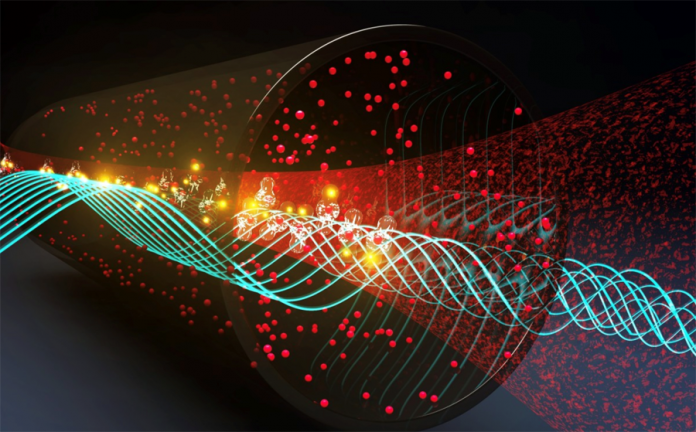Amazing! It was these very 'fingerprints' of time that the physicists behind this latest set of experiments set out to test, showing they were consistent and reliable enough to serve as a form of quantum timestamping.
All Humans have is the brief history of Time, and that has been changed recently!
Time is an entity without which human lives will come to an absolute stop, all our lives we have just been programmed to find a workable solution with respect to our time.
The inherent passage of time has been troubling us humans for eternity wherein prehistoric civilization recorded time with phases of Moon, nearly 30000 years ago. Their own reflections could only be expressed in time. . ."
READ MORE
✓ Current research directions Edit
Since 2000's Rydberg atoms research encompasses broadly five directions: sensing, quantum optics,[29][30][31][32][33][34] quantum computation,[35][36][37][38] quantum simulation[39][2][40][41] and quantum matters.[42][43] High electric dipole moments between Rydberg atomic states are used for radio frequency and terahertz sensing and imaging,[44][45] including non-demolition measurements of individual microwave photons.[46] Electromagnetically induced transparency was used in combination with strong interactions between two atoms excited in Rydberg state to provide medium that exhibits strongly nonlinear behaviour at the level of individual optical photons.[47][48] The tuneable interaction between Rydberg states, enabled also first quantum simulation experiments.[49][50]
Scientists Just Discovered an Entirely New Way of Measuring Time
Marking the passage of time in a world of ticking clocks and swinging pendulums is a simple case of counting the seconds between 'then' and 'now'.
Down at the quantum scale of buzzing electrons, however, 'then' can't always be anticipated. Worse still, 'now' often blurs into a haze of uncertainty. A stopwatch simply isn't going to cut it for some scenarios.
A potential solution could be found in the very shape of the quantum fog itself, according to researchers from Uppsala University in Sweden.
Their experiments on the wave-like nature of something called a Rydberg state have revealed a novel way to measure time that doesn't require a precise starting point.
Rydberg atoms are the over-inflated balloons of the particle kingdom. Puffed-up with lasers instead of air, these atoms contain electrons in extremely high energy states, orbiting far from the nucleus.
Of course, not every pump of a laser needs to puff an atom up to cartoonish proportions. In fact, lasers are routinely used to tickle electrons into higher energy states for a variety of uses.
In some applications, a second laser can be used to monitor the changes in the electron's position, including the passing of time. These 'pump-probe' techniques can be used to measure the speed of certain ultrafast electronics, for instance.
Inducing atoms into Rydberg states is a handy trick for engineers, not least when it comes to designing novel components for quantum computers. Needless to say, physicists have amassed a significant amount of information about the way electrons move about when nudged into a Rydberg state.
Being quantum animals, though, their movements are less like beads sliding about on a tiny abacus, and more like an evening at the roulette table, where every roll and jump of the ball is squeezed into a single game of chance.
The mathematical rule book behind this wild game of Rydberg electron roulette is referred to as a Rydberg wave packet.
Just like actual waves in a pond, having more than one Rydberg wave packet rippling about in a space creates interference, resulting in unique patterns of ripples. Throw enough Rydberg wave packets into the same atomic pond, and those unique patterns will each represent the distinct time it takes for the wave packets to evolve in accordance with one another.
It was these very 'fingerprints' of time that the physicists behind this latest set of experiments set out to test, showing they were consistent and reliable enough to serve as a form of quantum timestamping.
Their research involved measuring the results of laser-excited helium atoms and matching their findings with theoretical predictions to show how their signature results could stand in for a duration of time.
"If you're using a counter, you have to define zero. You start counting at some point," physicist Marta Berholts from the University of Uppsala in Sweden, who led the team, explained to New Scientist.
"The benefit of this is that you don't have to start the clock – you just look at the interference structure and say 'okay, it's been 4 nanoseconds.'"
A guide book of evolving Rydberg wave packets could be used in combination with other forms of pump-probe spectroscopy that measure events on a tiny scale, when now and then are less clear, or simply too inconvenient to measure.
Importantly, none of the fingerprints require a then and now to serve as a starting and stopping point for time. It'd be like measuring an unknown sprinter's race against a number of competitors running at set speeds.
By looking for the signature of interfering Rydberg states amid a sample of pump-probe atoms, technicians could observe a timestamp for events as fleeting as just 1.7 trillionths of a second.
Future quantum watch experiments could replace the helium with other atoms, or even use laser pulse of different energies, to broaden the guide book of timestamps to suit a broader range of conditions.
This research was published in Physical Review Research.

Professor Barry Dunning discusses new research in quantum electric field sensors using Rydberg atoms of a higher sensitivity
Electromagnetic (EM) radiation is critically important to the functioning of modern technological society in areas such as telecommunications, radar, and GPS navigation. Whereas EM waves are now typically detected using antennae and electronic receivers, recent work using atoms in highly-excited states, termed Rydberg atoms, has demonstrated that, following in the footsteps of quantum sensors of time (atomic clocks) and magnetic fields (magnetometers), controllable quantum systems can also provide a powerful electric field sensor (electrometer) that has the potential to reach unprecedented levels of sensitivity and selectivity. Quantum-based atomic sensors have the advantage over more traditional technologies in that all atoms of a given species possess identical characteristics which allows for repeatable, high precision measurements that can be directly related to known absolute standards.
As highlighted in a recent e-book,† atoms in which one
electron is excited to a Rydberg state possess many novel
characteristics. In particular, as their level of excitation increases
they become very large and can approach the size of a grain of sand.
The excited electron orbits so far from the nucleus and remaining
electrons that the electric field it experiences from them is very
weak. In consequence, its motion can be strongly perturbed by even very
small external electric fields and it is this sensitivity that forms
the basis for the use of Rydberg atoms in electrometry. . ." READ MORE


.jpg)
.jpg)
.jpg)


No comments:
Post a Comment